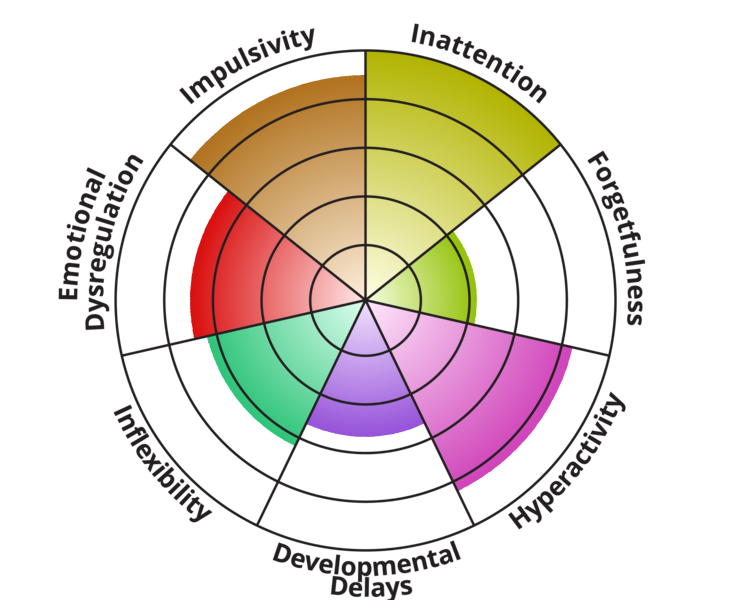ADHD Spectrum Test
You are here because one of your friends linked you to their ADHD Spectrum Test result:
Take the TestResults:

Your friend's ADHD symptoms are high.
Take the TestExplanation of Symptoms:
Inattention: Individuals on the ADHD spectrum often have difficulty sustaining their focus. They are often easily distracted and fail to pay sustained attention to minute details. As a consequence, they are easily bored, daydream a lot, and may not seem to listen well when spoken to. Many also have trouble following instructions, and they may steer clear of tasks that require a lot of focus.
Forgetfulness: Some people with a tendency toward ADHD can be identified by their inclination toward forgetfulness regarding their daily activities. These people often forget to do their chores, run errands, return calls, or pay their bills on time. It is usually challenging for such individuals to master efficient time management, finish schoolwork, and/or complete tasks in the workplace in an orderly fashion.
Hyperactivity: Hyperactivity pertains to excessive motor activity and difficulty in keeping still. People high in this symptom are often “on the go” as if driven by an inner motor. This is usually manifested as tapping, excessive fidgeting, extreme restlessness, and/or talkativeness. Those with this condition often wear other people out with their excessive need for activity.
Developmental Delays: Milder developmental delays often co-occur with ADHD, as children with this condition, when compared to their peers, may have difficulty with speech, motor skills, processing sensory information, or developing interpersonal relationships. Research has also linked the delayed development of the frontal brain regions’ cortical surface with ADHD (Shaw, et al., 2012).
Inflexibility: Some individuals on the ADHD spectrum have difficulty viewing occurrences from different perspectives or points of view, being inclined to sink back into established habits and patterns. These difficulties are often related to the broader problems these people face with regulating their responses, and this may develop into an inability to adapt fruitfully to novel situations (Farrant et. al., 2014).
Emotional Dysregulation: It is often difficult for people on the ADHD spectrum to modulate their emotional responses and expressions. Such tendencies may be manifested as excessive reactivity, low frustration thresholds, difficulty in calming down, and increased psychological distress. People high in this symptom often have frequent social conflicts and/or conduct problems in their lives.
Impulsivity: One symptom exhibited by many on the ADHD spectrum is the tendency toward hasty actions and spur-of-the-moment decisions. People with high levels of impulsivity may also suddenly throw themselves at activities that carry a high potential for risk or harm. Impulsivity may also be manifested as the inability to delay gratification and a tendency to be socially intrusive.
References
- Kessler RC, Adler L, Ames M, Demler O, Faraone S, Hiripi E, Howes MJ, Jin R, Secnik K, Spencer T, Ustun TB, Walters EE. (2005). The World Health Organization Adult ADHD Self-Report Scale (ASRS): a short screening scale for use in the general population. Psychol Med. 35(2):245-56. PMID: 15841682.
- Adler LA, Spencer T, Faraone SV, Kessler RC, Howes MJ, Biederman J, Secnik K. (2006). Validity of pilot Adult ADHD Self-Report Scale (ASRS) to Rate Adult ADHD symptoms. Ann Clin Psychiatry (3):145-8. PMID: 16923651.
- Adler, L., Faraone, S., Sarocco, P., Atkins, N., Khachatryan, A. (2018). Establishing US norms for the adult ADHD self-report scale and characterizing symptom burden among adults with self-reported ADHD. The International Journal of Clinical Practice.
- Farrant, B., Fletcher, J., & Maybery, M. (2014). Cognitive flexibility, theory of mind, and hyperactivity/inattention. Child Development Research. Philip Shaw, Meaghan Malek, Bethany Watson, Wendy Sharp, Alan Evans, Deanna Greenstein. Development of Cortical Surface Area and Gyrification in Attention-Deficit/Hyperactivity Disorder. Biological Psychiatry, 2012; 72 (3): 191.
- Shaw, P., Malek, M., Watson, B., Sharp, W., Evans, A., & Greenstein, D. Development of Cortical Surface Area and Gyrification in Attention-Deficit/Hyperactivity Disorder. Biological Psychiatry, 2012; 72 (3): 191.
GET THE FULL STORY
Become a lifetime member with a one-time payment
WHAT YOU GET
Access to premium, members-only tests
Access to all of our eBooks (value $44.94)
Access to 100s of premium articles
Access to 100s of premium type assessments
Access to premium infographics
New content continuously added
Become a memberGET THE FULL STORY
Thriving with ADHD
WHAT YOU GET
75-page manual, explaining the typical challenges and paths to growth experienced by people with ADHD traits.
Presented in an easy-to-read style and written by people who have grappled with these challenges themselves.
14-day, no-questions-asked, money-back guarantee.
Order NowGET THE FULL STORY
Manual of Personality Styles
WHAT YOU GET
71-page manual, explaining the make-up of all personality styles, their hidden drives, and the theory behind the system.
Presented in an easy-to-read style and backed up by solid academic references.
14-day, no-questions-asked, money-back guarantee.
Order Now
